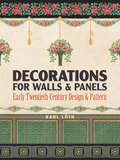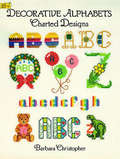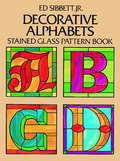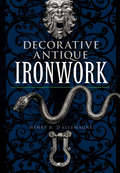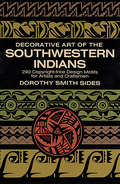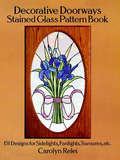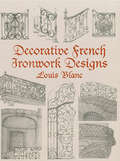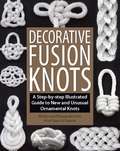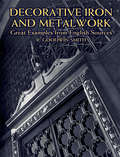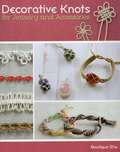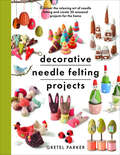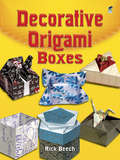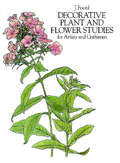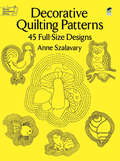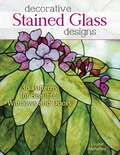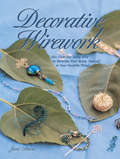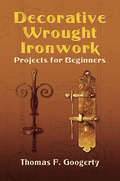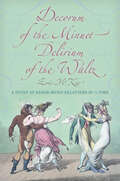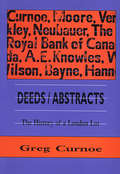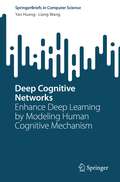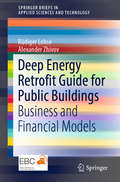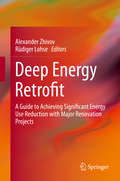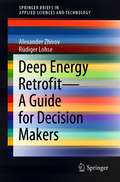- Table View
- List View
Decorations for Walls and Panels: Early Twentieth-Century Design and Pattern
by Karl LuthThis 128-page oversized catalog was produced circa 1900 in Germany and contains hundreds of stunning examples of screen-printed patterns and design elements originally conceived for wall and ceiling decoration. Created at the crossroads of Victorian and Art Nouveau styles, the catalog reflects the best European designs of the period. The full-color patterns, reproduced from rare originals, encompass decorations for every room in a variety of styles, including floral, animal, and geometric designs. In addition to allover patterns and borders, a wealth of individual motifs features cherubs, musical instruments, woodland scenes, seascapes, and other striking elements. Graphic artists and designers of all types will find this volume a splendid source of patterns and design inspiration.
Decorative Alphabets Charted Designs
by Barbara ChristopherCharted designs for 29 distinctive alphabets. Letters on balloons, trains, more. Ideal for counted cross-stich, needlepoint. Instructions, color keys.
Decorative Alphabets Stained Glass Pattern Book
by Ed Sibbett Jr.In this volume, noted artist and stained glass expert Ed Sibbett, Jr., has designed a handsome collection of alphabet and number patterns specifically for work in stained glass. In 61 pages of eminently usable patterns, Sibbett has rendered the letters of the alphabet in seven different fonts, six accompanied by the numerals 0 through 9. Styles range from a romantic Gothic to a bold, block-like modern and include examples of Art Nouveau, Art Deco, and abstract geometric lettering.Stained glass workers can apply these designs to window panels, mirrors, light catchers, lampshades, mobiles, and many other objects. Craft enthusiasts will want to use them to add eye-catching initials, monograms, words, dates, or phrases to a wide variety of projects.Decorative Alphabets Stained Glass Pattern Book offers stained glass workers and craft enthusiasts a versatile treasury of inexpensive alphabet and numeral motifs that will add flavor to almost any project.
Decorative Antique Ironwork
by Henry R. D’allemagne4,500 objects on 415 plates illustrate the remarkable variety of decorative ironwork from Roman times to the first part of the nineteenth century in this inexpensive Dover edition of all the illustrative material from the 1924 French catalogue of the extensive collection in the Le Secq de Tounelles Museum in Rouen. This pictorial documentation by the French scholar and collector Henry René d'Allemagne is the most valuable source of information now available for scholars, art historians, crafters, dealers, collectors, and those interested in antique ironwork.The work is divided into two parts. The first part, Architectural Ironwork, includes grilles, locks and padlocks, keys, escutcheons, door knockers, doorknobs, hinges and mountings, handles and pulls, bolts and latches, signs, and brackets. The second part, Small Iron and Steel Objects, includes jewelry, toilet accessories, key rings and handbag frames, small boxes, scissors and sewing accessories, smoking accessories, religious symbols and liturgical objects, sundials, tower and table clocks, bindings, notebook covers, furniture, lighting fixtures, grilles, fireplace accessories, kitchen equipment, and various tools and instruments.Informative captions include places of origins, materials used for new purposes, characteristics of the objects, and historical facts connected with them. The captions have been translated and supplemented with a new introduction and bibliography of d'Allemagne's work by Vera K. Ostola, Associate Curator of Medieval Art, the Metropolitan Museum of Art.
Decorative Art of the Southwestern Indians
by Dorothy S. SidesThe decorative art of the Indians of the American Southwest has long been recognized as one of the most beautiful art traditions in the primitive world. It demonstrates a technical skill with simple materials, a symbolic richness, and a faculty for creating rich effects by the imaginative use of ornament that are all almost unique. Museums use Pueblo ceramics for display pieces, and modern artists and crafters have turned eagerly to the handwork of prehistoric Indian women for inspiration and working ideas.Mrs. Dorothy Sides, a noted artist and collector, has gathered together and redrawn in black and white nearly 300 examples of the finest authentic Southwestern Indian decoration that she has seen in a lifetime of study. She has not limited her selection to one period or style, however; to make her book as useful as possible, she has selected material ranging from the thirteenth century great geometric art of the Pueblos to the handcrafts carried on by the nomadic and Pueblo peoples of the present.The main emphasis of this volume is on ceramic decoration, and Mrs. Sides includes pieces from the rich archeological sites of Pecos, Sikyatki, the Mimbres, and modern Pueblo pottery from Acoma, Zuni, Cochiti, and the Hopi. She also includes designs and motifs from the basketry of the Apache, Pima, and Papago; beadwork from the Mohave; authentic Zuni masks; Hopi kachina dolls; and sand paintings and blanket designs from the Navajo. This broad coverage of beautiful ornament illustrates many different art styles to fit every situation: geometric designs based upon balanced mirror fields of design, symbolic figures of the thunderbird, and modern stylizations. All is beautiful and imaginative.Any crafter working with ceramics will find this book indispensable as a source of rich, easily used, powerful design; workers in wood, weavers, metal workers, and leather workers will find that it will enlarge their decorative resources considerably. It also offers unusual and eye-catching designs for commercial artists who wish to do work suggesting travel, handcrafts, the Southwest, or the social sciences. Individual drawings are royalty-free and may be reproduced without fee or permission.
Decorative Doorways Stained Glass Pattern Book: 151 Designs for Sidelights, Fanlights, Transoms, etc.
by Carolyn ReleiThrough the centuries, stained glass designs have been used to decorate doorways and entries and to add to these essential architectural features a welcoming aura of beauty and light. Stained glass artist Carolyn Relei has created scores of elegant but simple designs for sidelights, fanlights, and transoms easily adaptable to the many different architectural and decorating styles popular today. Over 150 of her most beautiful designs are presented in this superb stained glass pattern book.The patterns, easily adaptable as templates, depict a wide variety of subjects, from trellised roses, soaring birds, and bouquets of tulips to geometric and abstract designs. Most of the shapes are elongated rectangles, ideal for transoms and sidelights, but Ms. Relei has added many beautiful half-circle fanlight designs and such popular stained glass shapes as the oval and circle to complete this outstanding collection. In addition to stained glass work, these lovely royalty-free designs have applications to many other art and craft projects.
Decorative French Ironwork Designs
by Louis BlancAntique lovers, architecture buffs, and graphic artists will treasure this magnificent collection of decorative French ironwork designs -- all of them authentic examples from the celebrated ornamental ironwork of Bordeaux. Over 1,500 handsome black-and-white illustrations depict painstakingly rendered balconies, gates, grilles, stair railings, doorknobs, and doorknockers.Meticulously reproduced with extraordinary clarity and remarkable detail, these elegant images are derived from a rare early twentieth-century volume privately printed in Paris. They incorporate floral and foliate designs, human and animal figures, musical motifs, heraldic crests, mythological figures, geometrics, and much more.A vibrant source of inspiration and royalty-free graphics, this collection offers artists and designers an affordable treasury of material that will bring period flair and decorative dazzle to a wide variety of art and craft projects.
Decorative Fusion Knots
by Barry Mault J. D. LenzenThe future of decorative knots has arrived!JD, the producer of over 100 instructional knot videos and the creator of the famed YouTube channel "Tying It All Together," reveals his innovative knotting style in Decorative Fusion Knots: A Step-by-Step, Illustrated Guide to Unique and Unusual Ornamental Knots.Respected internationally for his knotting skills and clear, concise video and book presentations, JD shows how to tie knots like no others. Just as origami figurines are created through the merging of different folding techniques, JD creates new knots by combining historical knot elements and new knotting techniques. The products of this intermingling are what he calls fusion knots - a brand new genre of knot in a centuries-old tradition. It is rare for a knot book to feature even one brand new, never-before-seen knot, but Decorative Fusion Knots features more than 25 brand new knots created by the author.Decorative Fusion Knots is the culmination of 10 years of study, practice and creation. The knots within were inspired by history, nature, mythology, and more. Many of these incredible knots have never been presented or described publicly, until now. Never before has a knot book presented a step-by-step format to tying brand new knots like this in full-color.Alongside fusion knots, JD presents logical and comprehensive instructions for a plethora of historical knots, including Celtic knots, Chinese decorative knots, maritime knots, and popular paracord ties. Each historical knot instruction is presented in step-by-step fashion with full-color photographs. In fact, over 300 step-by-step color photographs are included in the book, each accompanied with clear, concise instructional captions.Whether you're a sailor, teacher, jewelry maker, survivalist, general knot enthusiast, or just looking for bush crafts, paracord ties, a curriculum for students, or a fun way to pass the time, Decorative Fusion Knots is the book for you. With easy-to-understand captions and clear step-by-step photos, readers can learn at their own pace, review whole techniques at a single glance and simply lay the book flat on the table and follow along as they tie.
Decorative Iron and Metalwork: Great Examples from English Sources
by R. Goodwin-SmithMagnificent study by expert on age-old craft provides a spirited overview. 140 illustrations include grilles, doors, and gates; stair railings and balustrades; small handles, hinges, door-knockers, and keyhole plates; Elizabethan-era firedogs; weather vanes; much more, many never catalogued before. Rich source of inspiration, royalty-free graphics, information.
Decorative Knots for Jewelry and Accessories
by Boutique-ShaLearn to tie 78 different decorative knots to create unique handmade jewelry and other accessories.How to tie beautiful Japanese, Korean, Chinese, and Celtic knots from decorative cord, hemp twine, and embroidery flossIncludes 22 projects for using the knots, plus dozens of other ideas for creative usesFull instructions and step-by-step line drawings are given for each knotKnots can be used for bracelets, necklaces, anklets, pendant settings, and other jewelry, as well as bag handles, keychains, trims, button closures, and other practical uses
Decorative Needle Felting Projects: Discover the Relaxing Art of Needle Felting and Create 20 Seasonal Projects for the Home (Crafts Ser.)
by Gretel ParkerNeedle felting is the simple process of transforming wool into 3D objects using a barbed needle. It’s a fun craft that is easy to learn and gets amazing results. With just a few basic tools and simple step by steps, you'll be on your way to making your own adorable felted creations. In this beautifully designed book, discover the relaxing craft of needle felting and learn how to make delightful creations to use and wear. Following the basic method, many of the patterns can be resized and with the addition of techniques such as darning, patching and stitching, the home crafter can adapt each design to make their very own creations. Including clear step-by-step photos and concise instructions, the patterns are easy to follow, even for complete beginners. No previous needle felting experience is needed. All projects are designed to appeal to a broad base of crafters who will enjoy the added mixed media interest and the opportunity to take a basic pattern and develop it to suit their own needs. The projects range from the quick and easy, such as small Easter Egg Dangles, to the more complex, such as a Winter Gingerbread Village. Wearable designs include an Autumn Fox Bangle and a Midsummer Rose Corsage. This new and innovative approach to needle felting widens the creative possibilities beyond the core twenty patterns so the maker can choose to flex their creative wings and discover new approaches to the craft.
Decorative Origami Boxes
by Rick BeechForget the giftwrap--these unique boxes are perfect for gift-giving. In fact, they're handmade gifts all by themselves! Choose your own paper, and make a keepsake treasure--or make dozens! Step-by-step diagrams make it easy to create a work of art.A well-known British origami expert, Rick Beech is the author of several books. These unusual and imaginative designs appeal to paperfolders at every level of experience. This book features fifteen different patterns for boxes, along with some lid variations and decorative accents, offering a useful, affordable way to expand your origami repertoire.
Decorative Plant and Flower Studies: For Artists and Craftsmen
by J. Foord88 royalty-free drawings of 40 plants and flowers -- Daffodil, Apple and other more or less familiar species -- distinguished by their grace, impeccable draftsmanship, and botanical accuracy. Extensive texts include botanical history, peculiar characteristics, folklore, poetic renderings, and more. An artist's sourcebook imbued with the spirit of poetry!
Decorative Quilting Patterns: 45 Full-Size Designs
by Anne SzalavaryThis unique book introduces 45 full-sized decorative stitching designs for quilts in an exciting variety of motifs. They range from plant and animal life to abstract designs, and include such appealing subjects as a beautiful seashell, a tempting bunch of grapes, a regal blue jay, and a smiling frog -- all ready to add a charming touch to any quilt.In addition to the full-size designs, the book includes detailed instructions that will enable even beginning quilt stitchers to achieve perfect results.
Decorative Sketches: Architecture and Design Influenced by Nature in Early 20th-Century Paris
by René BinetAt the turn of the 20th century, artists and craftsmen throughout Europe and America were profoundly affected by a new art style that took its inspiration from nature. Generally referred to as Art Nouveau, the trend influenced all manner of creative types, from painters, illustrators, and architects to ironworkers, interior decorators, and designers of furniture and jewelry. Although broad and varied, the style is almost uniformly characterized by abstract, asymmetrical, curvilinear design. This "new art" both elevated the status of crafts to fine arts and brought objects into a harmonious relationship with their environment through the use of lines that were natural, vital, and, most importantly, organic.The decorative images in this volume, reproduced from a rare 1902 portfolio, reflect the era's exotic and imaginative approach to architecture and applied design. Sixty plates, 12 in full color and many with partial and varied color, exhibit the influence of the artwork of naturalist Ernst Haeckel on artist René Binet's designs, especially as related to Binet's "Monumental Door," prepared for the 1900 World's Fair in Paris. Illustrations reflecting the styles of Art Nouveau include a wealth of examples that range from doorbells and keys to stairways, fountains, jewelry, ceramics, and other items. Graphic designers, illustrators, architects, artists, and crafters will find this volume a rich source of ornamental ideas, authentic motifs, and design inspiration.
Decorative Stained Glass Designs
by Louise Mehaffey38 patterns for beautiful botanical and traditional designs for the home.
Decorative Wirework: 50+ Ideas For Using Wire to Decorate Your Home, Yourserlf, or Your Favorite Thin gs
by Jane DavisWith more than 50 projects to choose from, this is a great idea book for the beginning to advanced wirework enthusiast. Readers will find fresh, creative ideas for using wire, as well as clear instructions for basic elements in wire design. Author Jane Davis begins with simple projects, such as an open spiral bracelet, and then progresses to more advanced variations by adding beads and construction details for more elaborate projects, like a hinged box with ornate decorative elements. She demonstrates everything from loops and clasps to hinges and cages so readers can make brooches, bracelets, earrings, ornaments, candleholders, and window treatments. More than 100 photos and illustrations guide the reader through this must-have wire project and idea book.
Decorative Wrought Ironwork: Projects For Beginners (Dover Craft Books)
by Thomas F. GoogertyAn excellent introduction to the exciting world of ironwork, this easy-to-follow guide features dozens of simple, traditional plans for use by amateur craftspeople and students interested in metalworking. Articles in the collection have been selected for their simplicity, but some previous experience in at least a few of the more common, basic processes employed in forging metals is recommended.The manual contains everything metalsmiths and hobbyists could wish for, including precisely drawn-to-scale patterns, descriptive notes on the tools of the trade, and detailed instructions on the metalworking process. More than 45 illustrations provide clearly drawn designs for flowerpot holders and stands, ash trays, andirons, candlesticks, door latches and locks, hinges, lamps, door knockers, and other decorative domestic accessories. A rich source of information and inspiration, Decorative Wrought Ironwork Projects for Beginners invites hobbyists to choose from a remarkable variety of motifs that can be successfully fashioned with the help of working drawings and helpful notes on construction.
Decorum of the Minuet, Delirium of the Waltz: A Study of Dance-Music Relations in 3/4 Time
by Eric McKeeAn investigation of dance-music relations in two out of the three most influential social dances of the eighteenth and nineteenth centuries.Much music was written for the two most important dances of the eighteenth and nineteenth centuries, the minuet and the waltz. In Decorum of the Minuet, Delirium of the Waltz, Eric McKee argues that to better understand the musical structures and expressive meanings of this dance music, one must be aware of the social contexts and bodily rhythms of the social dances upon which it is based. McKee approaches dance music as a component of a multimedia art form that involves the interaction of physical motion, music, architecture, and dress. Moreover, the activity of attending a ball involves a dynamic network of modalities—sight, sound, bodily awareness, touch, and smell, which can be experienced from the perspectives of a dancer, a spectator, or a musician. McKee considers dance music within a larger system of signifiers and points-of-view that opens new avenues of interpretation.“McKee’s book . . . fulfils its aim: that of presenting dance-music relations in two out of three of the most popular ballroom dances in several centuries. To my knowledge, there is no other English publication on such intersection of topics—thus it deserves a place in the libraries of music and dance departments.” —Gediminas Karoblis, Dance Research“I think this is an important book for musicians and dance academics alike, since McKee proposes that to understand the musical structures of the minuet and waltz, “it is helpful to be aware of the bodily rhythms of the dance upon which they are based and the social contexts in which they were performed”. . . . McKee’s holistic approach illuminates the total experiences of all the participants. . . . highly informative on the importance of dancing at every level of society, and its varying social functions, during the eighteenth and nineteenth centuries.” —Dance Europe“McKee’s overall orientation is laudable, since functional dance music has largely been ignored by music analysts, and stylized dance music has been treated as if it had minimal connection to the practice of dancing. . . . Despite the amount of close music analysis, McKee’s writing is accessible to a wide range of readers. . . . One hopes that McKee has plans for a future book to follow the mid-century delirium of the waltz to its twentieth-century demise.” —Nineteenth-Century Music Review
Dedicated to the Study of Sword Making
by Joe KertzmanLet author Don Fogg help you build of one of the big blades, the lengthy lopper - the sword! His step-by-step sword-making process resonates well with enthusiasts who can't get enough of the romance, history, look, feel, usefulness, ethnic heritage and physical impressiveness of swords.
Deeds/Abstracts: The History of a London Lot
by Greg CurnoeBefore his tragic death in 1992, Greg Curnoe had submitted to Brick Books a manuscript based on extraordinarily detailed research into the history of 38 Weston, his address in London, Ontario. The result is a journal/collage that traces the occupancy of that one small plot of land hundreds of years back into aboriginal times when land in this country was not plotted according to the laws of geometry. Deeds/Abstracts is an intensely concentrated and particular cross-section of Canadian history, layer upon layer upon layer. Brick Books is proud to offer this exemplary work-in-progress (a 500-year diary can never be complete) assembled by a much-loved and keenly-lamented Canadian artist of the first importance. Front and back covers are after paintings by Greg Curnoe. The text includes 12 colour plates of photographs and Curnoe paintings.
Deep Cognitive Networks: Enhance Deep Learning by Modeling Human Cognitive Mechanism (SpringerBriefs in Computer Science)
by Liang Wang Yan HuangAlthough deep learning models have achieved great progress in vision, speech, language, planning, control, and many other areas, there still exists a large performance gap between deep learning models and the human cognitive system. Many researchers argue that one of the major reasons accounting for the performance gap is that deep learning models and the human cognitive system process visual information in very different ways. To mimic the performance gap, since 2014, there has been a trend to model various cognitive mechanisms from cognitive neuroscience, e.g., attention, memory, reasoning, and decision, based on deep learning models. This book unifies these new kinds of deep learning models and calls them deep cognitive networks, which model various human cognitive mechanisms based on deep learning models. As a result, various cognitive functions are implemented, e.g., selective extraction, knowledge reuse, and problem solving, for more effective information processing. This book first summarizes existing evidence of human cognitive mechanism modeling from cognitive psychology and proposes a general framework of deep cognitive networks that jointly considers multiple cognitive mechanisms. Then, it analyzes related works and focuses primarily but not exclusively, on the taxonomy of four key cognitive mechanisms (i.e., attention, memory, reasoning, and decision) surrounding deep cognitive networks. Finally, this book studies two representative cases of applying deep cognitive networks to the task of image-text matching and discusses important future directions.
Deep Energy Retrofit Guide for Public Buildings: Business and Financial Models (SpringerBriefs in Applied Sciences and Technology)
by Rüdiger Lohse Alexander ZhivovThis book provides detailed information on how to set up Deep Energy Retrofits (DERs) in public buildings, and shares in-depth insights into the current status of the major technologies, strategies and practical best practice examples of how to cost-effectively combine them. Case studies from Europe are analyzed with respect to energy use before and after renovation, reasons for undertaking the renovation, co-benefits achieved, resulting cost-effectiveness, and the business models employed. The building sector holds the potential for tremendous improvements in terms of energy efficiency and reducing carbon emissions, and energy retrofits to the existing building stock represent a significant opportunity in the transition to a low-carbon future. Moreover, investing in highly efficient building materials and systems can replace long-term energy imports, contribute to cost cutting, and create a wealth of new jobs. Yet, while the technologies needed in order to improve energy efficiency are readily available, significant progress has not yet been made, and “best practices” for implementing building technologies and renewable energy sources are still relegated to small “niche” applications. Offering essential information on Deep Energy Retrofits, the book offers a valuable asset for architects, public authorities, project developers, and engineers alike.
Deep Energy Retrofit: A Guide to Achieving Significant Energy Use Reduction with Major Renovation Projects (Springerbriefs In Applied Sciences And Technology Ser.)
by Rüdiger Lohse Alexander ZhivovThis book provides detailed information on how to set up Deep Energy Retrofits (DERs) in public buildings, and shares in-depth insights into the current status of the major technologies, strategies and best practice examples of how to cost-effectively combine them. Case studies from the U.S.A. and Europe show that that Deep Energy Retrofit can be achieved with a limited core technologies bundle readily available on the market. Characteristics of some of these core technology measures depend on the technologies available on an individual nation’s market, on the minimum requirements of national standards, and on economics (as determined by a life cycle cost analysis). Also, requirements to building envelope-related technologies (e.g., insulation levels, windows, vapor and water barriers, and requirements for building airtightness) depend on specific climate conditions. This Guide provides best practice examples of how to apply these technologies in different construction situations.High levels of energy use reduction using core technology bundles along with improvements in indoor climate and thermal comfort can be only achieved when a Deep Energy Retrofit adopts a quality assurance process. In addition to design, construction, commissioning, and post-occupancy phases of the quality assurance process, the Guide emphasizes the importance of clearly and concisely formulating and documenting the Owner’s goals, expectations, and requirements for the renovated building during development of the statement of work. Another important component of the quality assurance process is a procurement phase, during which bidders’ qualifications, their understanding of the scope of work and its requirements, and their previous experience are analyzed.The building sector holds the potential for tremendous improvements in terms of energy efficiency and reducing carbon emissions, and energy retrofits to the existing building stock represent a significant opportunity in the transition to a low-carbon future. Moreover, investing in highly efficient building materials and systems can replace long-term energy imports, contribute to cost cutting, and create a wealth of new jobs. Yet, while the technologies needed in order to improve energy efficiency are readily available, significant progress has not yet been made, and “best practices” for implementing building technologies and renewable energy sources are still relegated to small “niche” applications.Offering essential information on Deep Energy Retrofits, the book offers a valuable asset for architects, public authorities, project developers, and engineers alike.
Deep Energy Retrofit—A Guide for Decision Makers (SpringerBriefs in Applied Sciences and Technology)
by Rüdiger Lohse Alexander ZhivovMany governments worldwide are setting more stringent targets for reductions in energy use in government/public buildings. Buildings constructed more than 10 years ago account for a major share of energy used by the building stock. However, the funding and “know-how” (applied knowledge) available for owner-directed energy retrofit projects has not kept pace with new requirements. With typical retrofit projects, reduction of energy use varies between 10 and 20%, while actual executed renovation projects show that energy use reduction can exceed 50%, and can cost-effectively achieve the Passive House standard or even approach net zero-energy status (EBC Annex 61 2017a, Hermelink and Müller 2010; NBI 2014; RICS 2013; Shonder and Nasseri 2015; Miller and Higgins 2015; Emmerich et al. 2011).Building energy efficiency (EE) ranks first in approaches with resource efficiency potential with a total resource benefit of approximately $700 billion until 2030. EE is by far the cheapest way to cut CO2 emissions (McKinsey 2011, IPCC 2007). However, according to an IEA study (IEA 2014a), more than 80% of savings potential in building sector remains untapped. Thus, the share of deployed EE in the building sector is lower than in the Industry, Transport, and Energy generation sectors. Estimates for the deep renovation potentials show: €600-900bn investment potential, €1000-1300bn savings potential, 70% energy-saving potential, and 90% CO2 reduction potential.
